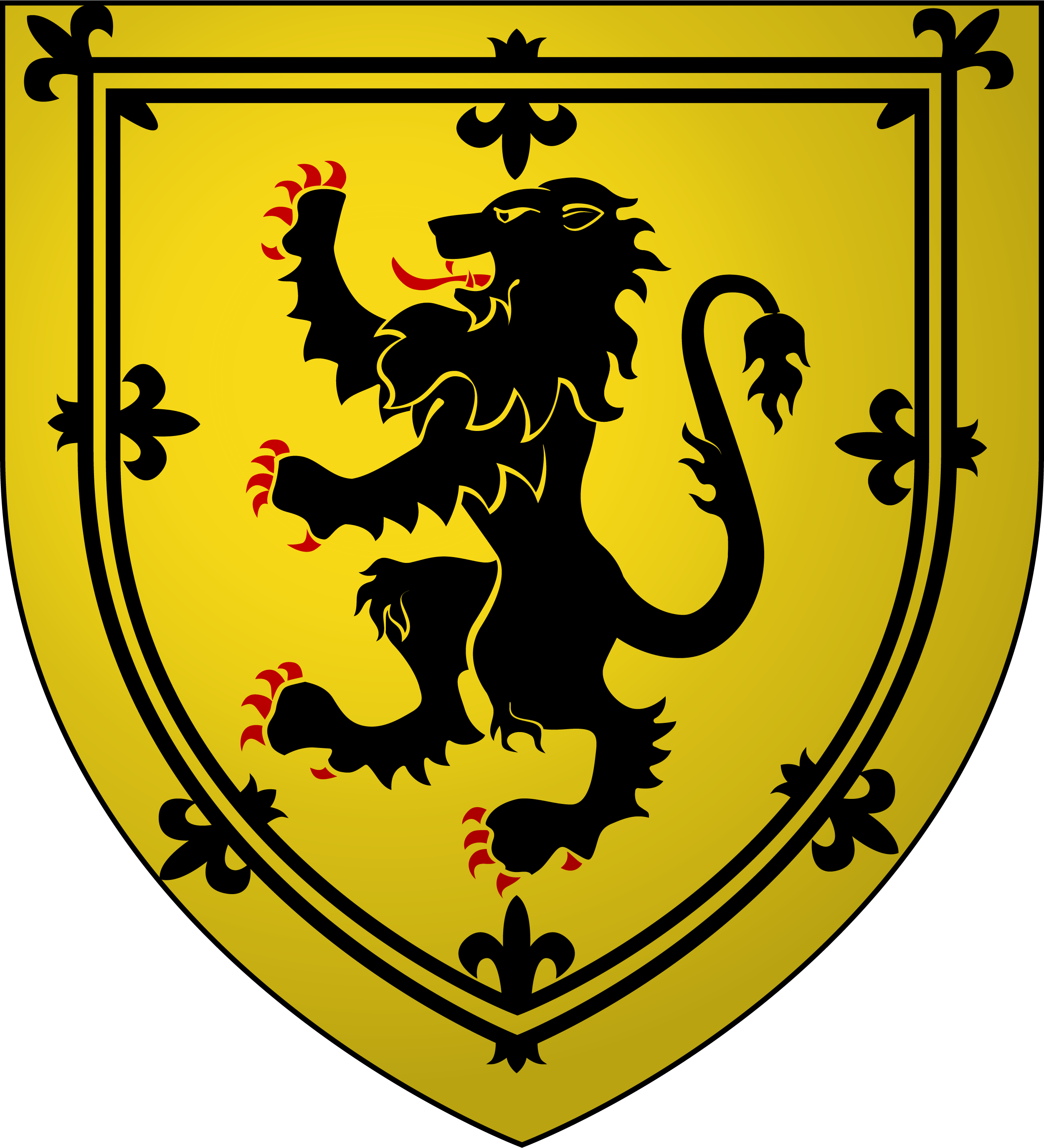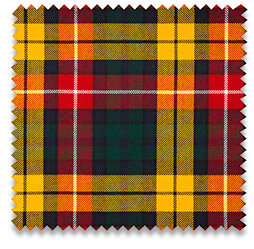Clan crest
“A dexter hand holding up a ducal cap proper, tufted on the top with a rose gules, within two laurel branches disposed orleways proper”
Coat of Arms of the Chief
“Or, a lion rampant sable armed and langued gules within a double tressure flory counterflory of the second”
Tartan
The Modern Buchanan Tartan
Considered by many as the official Buchanan Tartan – brilliant colors and an asymmetrical design.
Plant badge(s)
The Bilberry and the Oak
Before the renaissance of clan tartans. Before the Act of Proscription of 1747 which prohibited anyone to wear Highland Clothes. Before the uprising of 1745 and the Battle of Culloden. Scottish clans identified themselves by putting the Suaicheantas, or Badge, which was a sprig of plant, in their bonnet or cloak pin.
The Leadership of the Clan
In keeping with the modern organisation and clan folks’ expectations, the Clan is democratic and inclusive in its approach and decision-making.
The Clan is led by the Clan Chief, the first amongst equals, and is supported by groups that can be drawn on for advice and action.
The Clan has traditional or symbolic roles as well as delivering on important strategic and operational aspects. These are reflected in the traditional and modern clan organisational arrangements. The traditional organisation of the clan includes the Chief’s Household, the Clan Parliament and the Clan’s Armigers. The modern is the Clan’s Society, the Clan Buchanan Society International (CBSI).
The Chief
First, and foremost the leadership of the clan is provided by our Clan Chief: John Michael Baillie-Hamilton Buchanan of that Ilk and Arnprior, Chief of the Name and Arms of Buchanan. As this is now a modern role (the first time in over 340 years) there is a balancing act of tradition and modern procedures.
Unlike the pre-18th-century chiefs, a 21st-century chief is not going to lead their clan in war or demand rents and levies. The experience of other clans is that their 21st-century chief:
adds to the clan's sense of completeness;
adds to the perceived prestige of the clan;
performs and adds dignity to ceremonial duties;
enables the clan to speak with one voice;
helps to focus clan effort on matters of clan wide interest;
represents clan interests in multi-clan forums;
promotes the right use of chiefly arms and associated heraldry;
promotes a general awareness and increased use of heraldry by the clan folk;
interacts with the clan society in a similar way to how a constitutional monarchy interacts with the elected governments of his or her subjects;
appoints lieutenants to represent them when they cannot be present; and
uses modern communications to achieve effective (sometimes synchronous) communication between him or herself, the lieutenants and the clan folk.
The Chief’s Household
The Chief’s Household reflects the personal and the traditional roles of the Chief and the family in the Clan.
This involves the members of the Chief’s family and appointments that the Chief can make to support their personal representation and ceremonial aspects of the Clan. These include the Chief’s
Herald / Seanachie
Standard Bearer
Swordbearer
Pipers
Personal representatives (like Lieutenant and Commissioners).
The Clan Parliament
Sometimes called a Clan Council. The Clan Parliament brings all the members of the Clan together to give strategic direction to the clan.
The Clan Parliament aims to meet every four or five years to set direction and review progress on its decisions.
It stems from the tradition of the clan’s leadership group deciding upon issues of clan law, people, the estate, and their participation in skirmishes and the survival of the clan (which are mostly irrelevant today). However, there are different issues in the modern world that a clan needs to address for its survival. Once decided, those directions are then implemented via the Clan Society. At the same time as the Parliament, the clan takes the opportunity to bring together clan folk from around the world to tell and hear the clan’s stories, to visit clan sites, participate in clan activities, enjoy the Scottish culture and heritage.
The Council of Armigers
CLICK HERE TO LEARN ABOUT ARMIGERS
The Council of Armigers aims to optimize the strategic leadership of the Clan to promote Clan interests globally with due regard for tradition, Scottish law, and contemporary needs and opportunities. The Council would subscribe to the view that the principal interest of the Clan is not power, influence, glory, history, heraldry nor even honour, per se; rather, it is the encouragement of the clan folk to learn, enjoy and celebrate their unique Buchanan, Highland, Scottish heritage. It is against this interest that the Council's efforts are to be evaluated.
Its establishment is being considered and is likely to be formalised at the Chief's inauguration.
People seeking to sit as an Armiger, includes those persons granted Coats of Arms by established Heraldic authorities, eg. the Lord Lyon King of Arms for Scotland, the College of Arms (UK), should contact the Herald, Malcolm Buchanan.
For the Lord Lyon King of Arms for Scotland see www.courtofthelordlyon.scot. For the College of Arms (UK) see www.college-of-arms.gov.uk
The Clan Buchanan Society International (CBSI)
The CBSI plays a very important role in the Clan by working to deliver the outcomes set by the clan, to support its members and, through this, the Clan.
The CBSI is well suited to assist, as we have Regents ready and waiting in the UK and Ireland, North and South America, and Oceania.




